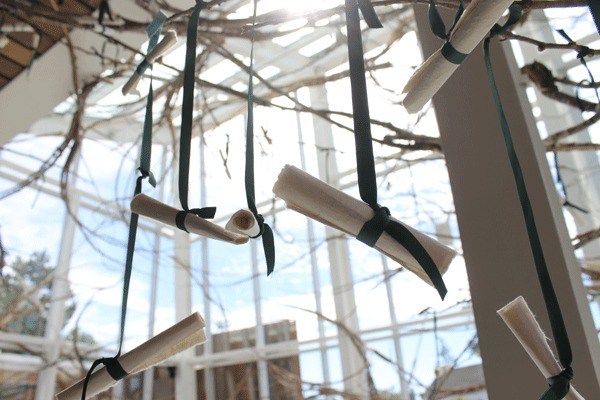Wander into the San Juan Islands Museum of Art atrium and you’ll hear the lively squeaks of orcas, the low moans of a drifting barge and the sloshing of a shoreline. High above in the atrium’s ceiling, cedar and willow branches curve and swirl like eddies, before sloping down to the floor to curl around the pillars and walls. Delicate ribbons in shades of greens and blues hang from the branches, swinging in the breeze like a fanciful kelp bed, weighed down with handwritten wishes, prayers and thoughts.
“Liminal Currents: Exploration of an Empathetic Umwelt” is the first major community collaboration at IMA, as well as the first conceptual installation.
“It’s very different for Friday Harbor,” said IMA advisor Diane Martindale. “We’ve never had an exhibit space like this before, and we’ve never had an installation like this before.”
The installation was designed and directed by local artist Matthew Gray Palmer, with assistance from community members. According to Palmer, umwelt, a German word pronounced oomvelt, is defined as “the world as it is experienced by a particular organism.”
One of the goals of the exhibit, said Martindale, is to allow people to try and experience the world through the lens of a marine organism.
Palmer’s brother, Grammy nominated musician Chuck Palmer, composed the sound design for the exhibit with help from the Salish Sea Hydrophone Network and used voices from local resident orca pods J, K and L.
“By engaging our capacity for imagining what another being experiences, our empathy, we might shift our perspective to include a fuller picture as we consider the ways in which we have, do and will connect, communicate and share the world and it’s sustaining energy with all of the denizens of this jewel,” wrote Matthew Palmer in his artist’s statement.
The exhibit comes with the opportunity for visitors to write on a small piece of paper, roll it up and tie it to a branch. Martindale has left a box outside the door so they can be dropped off after hours. Yoga mats are provided for those who want to spend time in the exhibit.
“Most everyone who come here come for a reason,” Martindale says. “Many for their love for the environment. This is just another way to treasure that and another way to look at it.”
The exhibit is free and open to the public 11 a.m. to 4 p.m. Thursday to Sunday until Aug. 21.




